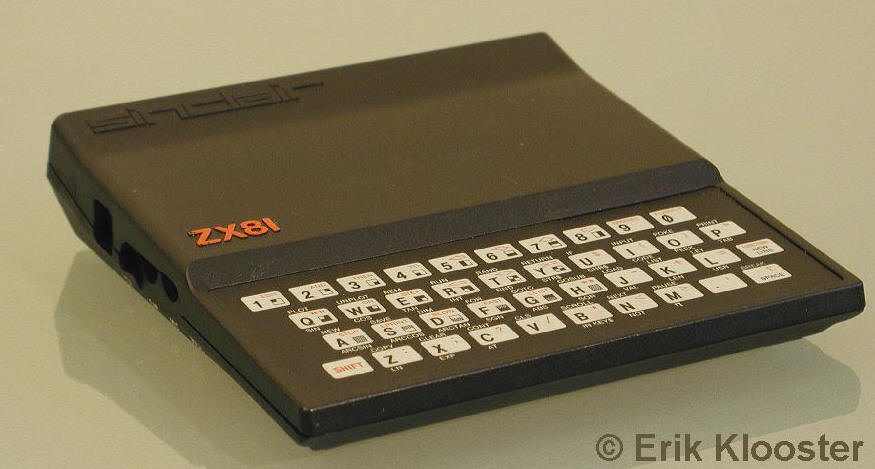
HISTORY OF HOME AND GAME COMPUTERS

| Navigator | ||||||||||||||||||
|
|
|
|
||||||||||||||||
|
|
||||||||||||||||||
 |
 |
Welcome to the nostalgic
history of home and game computers
![]()
SINCLAIR ZX81
home computer for a minimum prize
 In 1980 the eccentric Briton Clive
Sinclair already made
the impossible possible by selling a home computer, the ZX80, for less
then 100 British pounds, in 1981 he again hit the headlines. The successor
of this tiny white computer, the ZX81, was sold for the amazing price of
70 pounds, or 100 dollar in the United States. Thus the inventor of
miniature devices made it possible for hundreds of thousands of people to
get acquainted with the world of the computer. About a million ZX81
computers were sold in and outside Europe. In 1980 the eccentric Briton Clive
Sinclair already made
the impossible possible by selling a home computer, the ZX80, for less
then 100 British pounds, in 1981 he again hit the headlines. The successor
of this tiny white computer, the ZX81, was sold for the amazing price of
70 pounds, or 100 dollar in the United States. Thus the inventor of
miniature devices made it possible for hundreds of thousands of people to
get acquainted with the world of the computer. About a million ZX81
computers were sold in and outside Europe. |
Improvements
It was clear that the ZX80 was the mother of the ZX81. There weren't tremendous differences, although the ZX81 had some important improvements you could tell even with a minor glance at the photobooks out at the time. The 8 KB ROM (the ZX80 only had 4 KB) contained thirty extra commands of
Sinclair's Basic. And the ZX81 could handle floating point numbers, an
essential ability the ZX80 lacked.
Besides, it was possible to by-pass the weird ZX80 phenomenon that the
display function was shortly switched off when a key was touched. By a
Basic command the ZX81 could be brought into a SLOW- or a FAST-mode. In
the FAST-mode the ZX81 still had the same flaw as the ZX80, but in the
SLOW-mode the CPU could divert it's attention between the output to the
screen and other activities. Unlike the CPU's in other home computers, the
central processor in the ZX80 and ZX81 also handled the display function.
Clive Sinclair had radically changed the inside of his tiny home
computers. Whereas the ZX80 contained 21 chips, in the inside of the ZX81
there were only four - an unbelievable minimum in those years. The
reduction was possible because the ZX81 had and Ferranti ULA-chip, that
took care for all in- and output.
Disadvantages
A flaw that also returned in the ZX81 was related to the memory expansion pack that could be plugged into the back of the computer. Even during normal use of the computer the module could start to wobble, which often resulted in a temporary crash of the ZX81 and forced the user to enter his cursed Basic listing again. In the manual Sinclair unashamedly proposed to solve the problem by putting the computer and the expansion pack together with a piece of tape. |
Many extensions
While the ZX80 was a bit lonely, for the
much more popular ZX81 many different extension options were developed.
Manufactures, but also hobbyists themselves, quickly started to develop
external keyboards that made typing a far less tiresome activity. And when
you also had a memory pack, you suddenly had the disposal of an almost
mature home computer.
Later in 1981, Sinclair produced the well-known thermal printer. Also in
this device Sinclair had sought the absolute minimum ('a silver
toilet-roll burner'), so other manufacturers started to sell alternatives.
Memotech for instance developed a Centronics interface by which more
common printers could be used.
The amount of extension options that appeared for the ZX81 was almost
inexhaustible. The possibilities varied from graphical upgrades to 3.5
inch floppy drives.
 Top computer Top computerActually I already regret the few critical comments I made on the ZX81. In the early eighties Clive Sinclair provided beginning computer users with a nice home computer for an absolute minimum price. For many, particular in Europe, the ZX81 was the first home computer and thus their first contact with a new, amazing world. |
Specifications of the Sinclair ZX81
| Manufacturer | Sinclair Research |
| Period | from March 1981 |
| CPU | Zilog Z80A or NEC D780C |
| Frequency | 3,25 MHz |
| ROM | 8 KB |
| RAM | 1 KB (expandable to 56 KB) |
| Text mode | 32 x 24 |
| Graphical mode | 64 X 44 (by half characters) |
| Colours | black-and-white |
| Sound | none |
| I/O | tv, cassette, extension port |
| Price | 70 pounds / 100 dollar
ready-built 50 pounds / 80 dollar self-assembly kit |
| News | |||
|
|
|
|
|
|
|
|||
View results from last poll:
how many games you have? (3127
votes)


